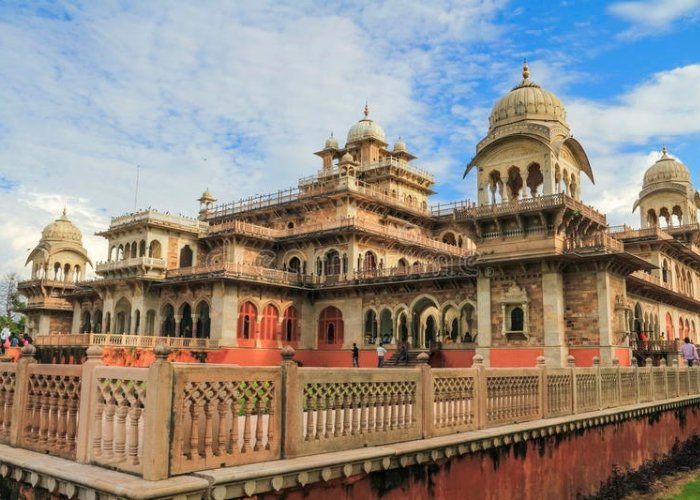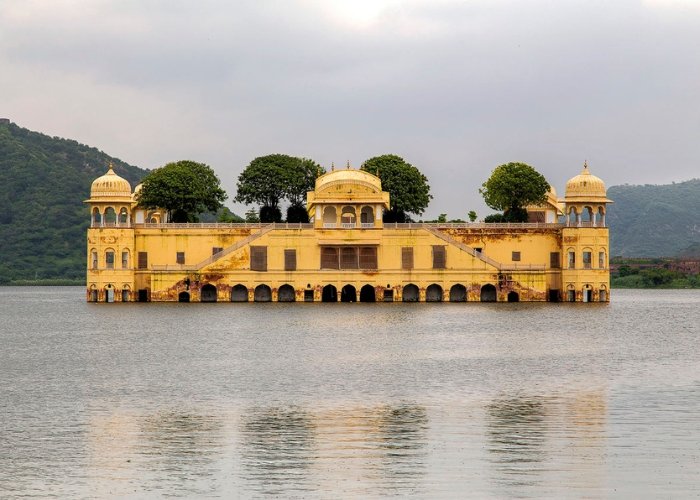Pink City
Jaipur Rajasthan
The city of Jaipur was founded by the King of Amber, Maharaja Sawai Jai Singh II on 18 November 1727, who ruled from 1699 to 1743. He planned to shift his capital from Amber, 11 kilometres (7 mi) to Jaipur to accommodate the growing population and increasing scarcity of water.
Jai Singh consulted several books on architecture and architects while planning the layout of Jaipur. Under the architectural guidance of Vidyadhar Bhattacharya, Jaipur was planned based on the principles of Vastu Shastra and Shilpa Shastra. The construction of the city began in 1726 and took four years to complete the major roads, offices, and palaces. The city was divided into nine blocks, two of which contained the state buildings and palaces, with the remaining seven allotted to the public. Huge ramparts were built, pierced by seven fortified gates.

Places to Visit in Jaipur
Jaipur is a major tourist destination in India forming a part of the Golden Triangle. In the 2008 Conde Nast Traveller Readers Choice Survey, Jaipur was ranked the 7th best place to visit in Asia. Visitor attractions include the Birla Auditorium, Albert Hall Museum, Hawa Mahal, Jal Mahal, City Palace, Amer Fort, Jantar Mantar, Nahargarh Fort, Jaigarh Fort, Birla Mandir, Galtaji, Govind Dev Ji Temple, Garh Ganesh Temple, Moti Dungri Ganesh Temple, Sanghiji Jain temple and the Jaipur Zoo.

Albert Hall Museum
The Albert Hall Museum in Jaipur is the oldest museum of the state and functions as the state museum of Rajasthan, India. The building is situated in Ram Niwas garden outside the city wall opposite New gate and is a fine example of Indo-Saracenic architecture. It is also called the Government Central Museum.
The museum has a rich collection of artifacts including paintings, jewelry, carpets, ivory, stone, metal sculptures, and works in crystal. The collection includes coins from the Gupta, Kushan, Delhi Sultanate, Mughal and British periods.

City Palace
City Palace, Jaipur was established at the same time as the city of Jaipur, by Maharaja Sawai Jai Singh II, who moved his court to Jaipur from Amber, in 1727. Jaipur is the present-day capital of the state of Rajasthan, and until 1949 the City Palace was the ceremonial and administrative seat of the Maharaja of Jaipur. The Palace was also the location of religious and cultural events, as well as a patron of arts, commerce, and industry. It now houses the Maharaja Sawai Man Singh II Museum, and continues to be the home of the Jaipur royal family.

Hawa Mahal
The Hawa Mahal is a palace in the city of Jaipur, India. Built from red and pink sandstone, it is on the edge of the City Palace, Jaipur, and extends to the Zenana, or women's chambers. The structure was built in 1799 by the Maharaja Sawai Pratap Singh, grandson of Maharaja Sawai Jai Singh, the founder of the city of Jaipur, India. He was so inspired by the unique structure of Khetri Mahal that he built this grand and historical palace

Jal Mahal
Jal Mahal is a palace in the middle of the Man Sagar Lake in Jaipur city, the capital of the state of Rajasthan, India. The palace was originally constructed in 1699; the building and the lake around it were later renovated and enlarged in the 18th century by Maharaja Jai Singh II of Amber. The Jal Mahal palace is an architectural showcase of the Rajput style of architecture (common in Rajasthan) on a grand scale. The building has a picturesque view of Man Sagar Lake, but owing to its seclusion from land is equally the focus of a viewpoint from the Man Sagar Dam on the eastern side of the lake in front of the backdrop of the surrounding Nahargarh ("tiger-abode") hills.

Galtaji
Galtaji is an ancient Hindu pilgrimage about 10 km away from Jaipur, in the Indian state of Rajasthan. The site consists of a series of temples built into a narrow crevice in the ring of hills that surrounds Jaipur. A natural spring emerges high on the hill and flows downward, filling a series of sacred kunds (water tanks) in which pilgrims bathe. Visitors and pilgrims can ascend the crevasse, continuing past the highest water pool to a hilltop temple from there are views of Jaipur and its fortifications spreads out across the valley floor. It is believed that a Saint named Galav lived here, practiced meditation, and did penance.

Amer Fort
Amer Fort or Amber Fort is a fort located in Amer, Rajasthan, India. Amer is a town with an area of 4 square kilometres located 11 kilometres from Jaipur, the capital of Rajasthan. The town of Amer and the Amber Fort were originally built by Raja Man Singh and additions were, later, made by Sawai Jai Singh. Located high on a hill, it is the principal tourist attraction in Jaipur. Amer Fort is known for its artistic style elements. With its large ramparts and series of gates and cobbled paths, the fort overlooks Maota Lake,[3][4][5][6] which is the main source of water for the Amer Palace.

Jantar Mantar
A Jantar Mantar is an assembly of stone-built astronomical instruments, designed to be used with the naked eye. There were five Jantar Mantars in India, all of them built at the command of the Rajah Jai Singh II, who had a keen interest in mathematics, architecture and astronomy; The largest example is the equinoctial sundial belonging to Jaipur's assembly of instruments, consisting of a gigantic triangular gnomon with the hypotenuse parallel to the Earth's axis. On either side of the gnomon is a quadrant of a circle, parallel to the plane of the equator. The instrument can be used with an accuracy of about 2 seconds by a "skilled observer" to measure the time of day, and the declination of the Sun and the other heavenly bodies. It is the world's largest stone sundial, known as the Vrihat Samrat Yantra. The Jaipur Jantar Mantar is a UNESCO World Heritage Site.

Birla Mandir
Birla Mandir, Jaipur (Lakshmi Narayan Temple) is a Hindu temple located in Jaipur, India and is one of many Birla mandirs. It was built by the B.M. Birla Foundation in 1988 and is constructed solely of white marble. It is dedicated to the Hindu Goddess Lakshmi and Lord Vishnu (Narayan), whose images appear inside, along with other Hindu gods and goddesses and selections from the Gita and Upanishads. Festivals such as Diwali and Janamashtami are celebrated at the temple. The temple is open daily with visiting hours between 8:00 AM and 12:00 PM, as well as between 4:00 PM and 8:00 PM. It is located in Jaipur's Tilak Nagar neighborhood near Moti Dungari hill.
Places nearby
- Achrol Fort
- Pushkar
- Bagru
- Samode
- Sambhar Lake
- Bhangarh Fort
- Mandawa
- Jaigarh Fort
- Chokhi Dhani
- Jhalana Leopard Safari
- Elefantastic
- Panna Meena ka Kund
